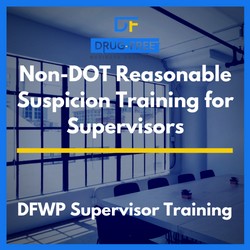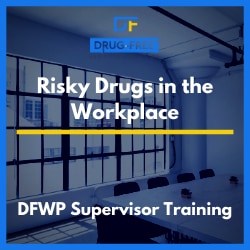What constitutes reasonable suspicion for drug testing? We cover the answer to this question in our Reasonable Suspicion for Drug Testing course for non-DOT supervisors and program administrators.
This course trains supervisors and program administrators how to determine whether they have cause to test on reasonable suspicion. Get your reasonable suspicion drug testing training right here!
What Does it Mean to Have Reasonable Suspicion?
We cover the definition of reasonable suspicion, and we thoroughly explain the degree of certainty required to administer a reasonable suspicion drug test.
What Qualifies as Reasonable Suspicion for Drug Testing?
We then discuss the types of evidence that can support reasonable suspicion drug testing. Learn the observable signs and behavioral indicators of current drug and alcohol use.
It is important that you have sufficient evidence that is well-documented to support your reasonable suspicion decision.
Because you are going to have to confront the employee under scrutiny, and you want to have a solid explanation for why you are making them take a drug test.
And further, you have to document your observations for the drug-free workplace program.
We discuss how to categorize and document your observations so that they are clear and articulable. There are reasonable suspicion drug testing laws, and we want to make sure you stay within bounds in your decision-making.
Present-Time and Articulable Evidence Standards for Observations of Employees
Then we explain the standards that your observations must meet. It cannot simply be that, for example, you think Jim looks a little off or groggy this morning. It requires more detailed observation than that.
While you need to use your instinct in determining reasonable suspicion for drug testing, you also then need to build up further observable evidence beyond that instinct.
And that evidence must meet a certain standard. We run through a reasonable suspicion drug testing checklist of the standards for observations of employees.
For example, present drug and alcohol use is one of the most important matters. If Jim is checking all the boxes for evidence of drug use today, you must pull him out of duty and test him today! Not tomorrow or next week.
You want to get a drug test that paints an accurate picture of Jim’s drug and alcohol levels at the time of your observations.
Time is probably the single biggest standard for your observations.
Reasonable Suspicion Drug Testing Scenarios When Testing is Not Warranted
After defining reasonable suspicion, explaining the types of evidence you must procure, and detailing the standards for that evidence, we then move into scenarios where reasonable suspicion testing is not warranted.
We go over the circumstances in which you are out of bounds administering a reasonable suspicion drug test.
Related Courses






